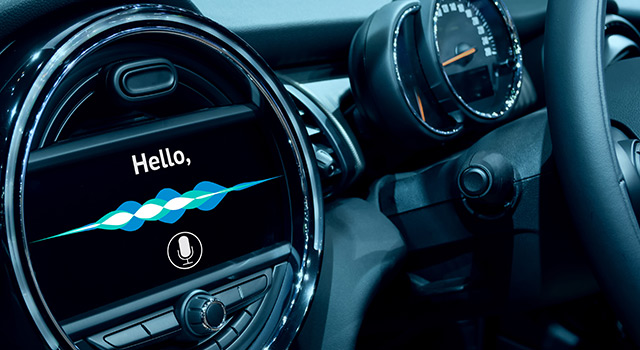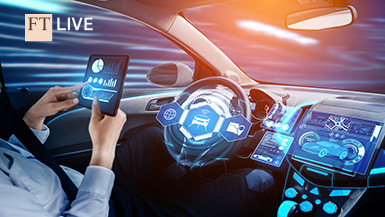AUTOMOTIVE, IN-CABIN EXPERIENCE: PERSONALIZED DIGITIZED, IMMERSIVE
A mobile device with a slick, touchscreen main user interface gives access to an array of entertainment, information, and navigation functions, and provides always-on, mobile broadband internet via a 5G network. Does this sound like a description of a latest smartphone? Or the latest, automotive, in-cabin experience? Today, it aptly describes the next generation of immersive, in-cabin experience in cars to be launched in the coming months and years. The appeal of these automotive, in-cabin experience cars will be as much about their apps, user interface, and audio and video features as it is about driving dynamics, design, and comfort—the features that car makers have traditionally drawn on to sell their latest models.
The automotive, in-cabin experience has transformed into a true, digital experience: the software environment in the vehicle enables consumers to make a seamless transition from their home or office to their vehicle, while enjoying the same immersive entertainment options, productivity tools, and communication options everywhere. Third-party apps will run in the car just as they do on the mobile phone—seamless connectivity is truly at hand in today’s in-cabin experience.
for in-cabin, AI market by 20261
Seamlessness notwithstanding, while the worlds of the mobile phone and the car are converging, there is one difference: the mobile phone is a personal device which has a single user, while a car is often jointly owned, and the cabin can be a space shared with one or more passengers. Each person in the cabin might have their own music playlists and playback preferences, as well as different people in their list of contacts to call. Therefore, all these passengers will want to be able to immerse themselves in their own personalized, digital worlds inside the car just as they do outside it.
The key challenge today for automotive technology suppliers is how digitization and personalization can be combined for an immersive, yet safe, automotive vehicle, in-cabin experience—which is one challenge Analog Devices is uniquely qualified to address with innovative and exciting answers.

“The future of automotive in-cabin is being driven by three concepts: First is the digitization of content—maps, contacts, media, etc. Second is driver and user personalization and bringing our home environment to the vehicle. And third is immersive cabin experience, including applications like noise cancellation to improve in-cabin audio and voice.”Greg Henderson
Senior Vice President of Automotive, Communications, and Aerospace Group | Analog Devices
YOUR IN-CABIN EXPERIENCE, YOUR WAY
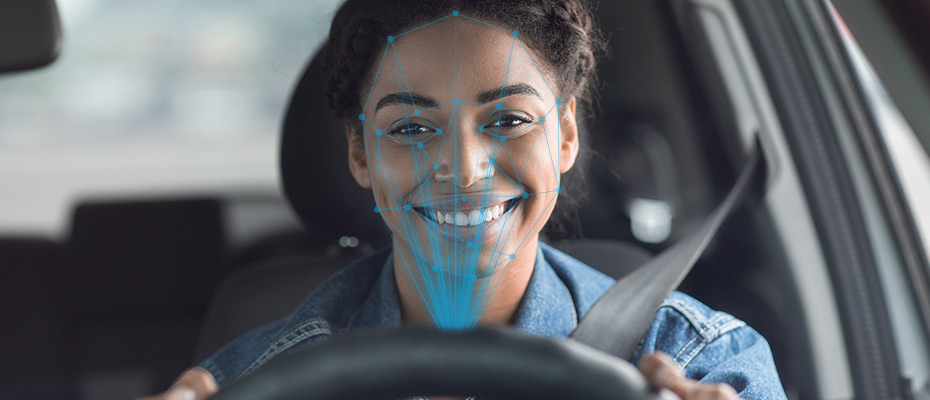
Technology is finding unique, exciting, new ways to reconfigure the car’s digital settings to fit your preferences. As soon as you settle in behind the steering wheel, the camera in the driver monitoring system can perform facial recognition to identify who is in control of the vehicle. Elsewhere in the cabin, other discreet methods for user identification may be used, such as voice or fingerprint recognition.
Once recognized, your personalized comfort settings kick in, including seat position and cabin temperature. As the car is a connected digital device, your content and information can be synchronized seamlessly. When the car starts up, its audio system will automatically finish playing the podcast you were listening to and continue on to your playlists.
Like a phone, the car’s entertainment, productivity, and other apps will be continually refreshed with over-the-air software updates, a practice pioneered by Tesla but which is set to become routine across the automotive industry. These software updates will be driven by a mix of native and third-party apps you installed—proving the automotive, in-cabin experience to be as personalized a software environment as your mobile phone.
IMMERSED IN YOUR PERSONAL CONTENT
If a car’s digital environment provides your personal content library, the cabin needs to provide the stage on which this library may be played. In the past, your choice of infotainment function affected every passenger’s experience. It was either Beethoven or Beyonce on the audio system—not both. Today’s automotive vehicle, in-cabin experience is poised to change all that.
Already, luxury vehicles provide a display screen for each passenger. Now, car makers are deploying advanced technology that creates a personal audio zone for each passenger. This builds on noise cancellation technology familiar to headphone users and extends it to place each passenger inside an audio bubble. Here, they can listen to their preferred music and make video calls without disturbing anyone else.
Oftentimes, the entertainment unit in a car is the best hi-fi system that a consumer owns—better than anything inside their home. It is perhaps surprising, but certainly true, that the quality of the audio system can be the reason that a consumer chooses to buy one brand’s car rather than a competitor’s. The emergence of personalized audio could accentuate the value of car hi-fi more than ever.
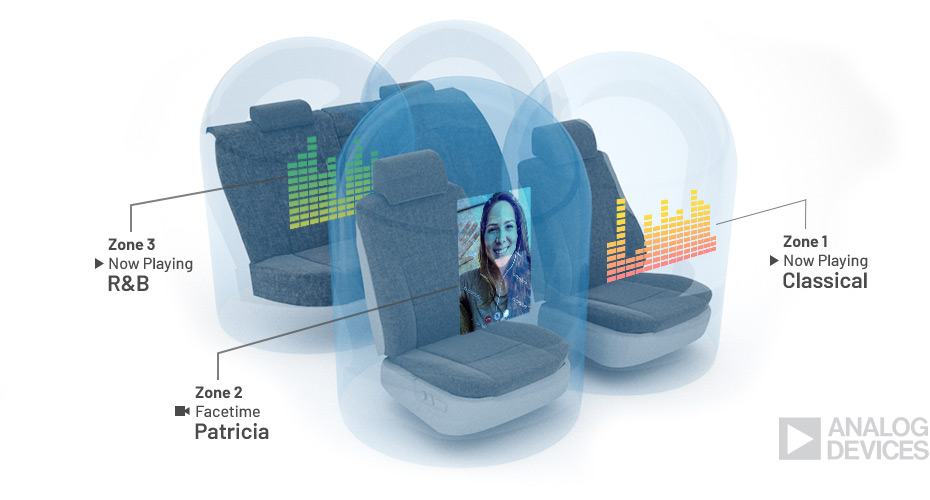
THE CAR AS A PERSONAL, DIGITAL ASSISTANT
Consumers have become quite comfortable with talking to a personal digital assistant (PDA) to control home convenience and entertainment functions. “Siri, what time is it?” “Alexa, play my rockin’ playlist.” In the car, voice control is not only more convenient than conventional user input technologies (touchscreens or buttons) it’s safer, since it doesn’t require the driver to take their eyes off the road.
Gesture-sensing controls can also provide safer ways for the driver to interact with audio, ventilation, and other systems in the car. Implementing this vision of an immersive digital experience in vehicles calls for a combination of advanced technologies and knowledge of the automotive operating environment, with its emphasis on safety, reliability, and efficiency.
Analog Devices is already working with automotive manufacturers to help them deploy MEMS microphones with beamforming capabilities for voice control, backed by AI software technology for local speech recognition. ADI’s advanced noise cancellation systems can muffle road noise and create personal audio bubbles, while allowing safety-critical sounds to reach the driver. Integrating microphones, digital audio systems and advanced DSPs backed by sensors such as accelerometers, the latest ADI noise cancellation technology offers revolutionary performance that provides a silent backdrop for new immersive digital experiences in the cabin.
Watch a demo of beamforming voice processing technology in action
MORE CAPABILITIES, FEWER WIRES
The growing range of software-controlled features in the car is leading to an explosion in the number of network nodes in the car, and in the volume of signals the networks carry. Traditional networking technologies deployed in the car require extra cabling for every additional node and connection. This means that the cable harness is one of the heaviest and most expensive components of a car.
Sophisticated bus network technologies such as ADI’s A2B® technology can reduce the length of cabling in the vehicle, resulting in weight savings that can substantially reduce energy consumption. New wireless networks for elements of the car’s data or entertainment systems can also eliminate the weight and cost of physical cabling entirely.
ADI’s Gigabit Multimedia Serial Link (GMSL) SerDes technology provides the high bandwidth requirements needed to transport a burgeoning volume of multitype data to enable sophisticated advanced driver assistance systems (ADAS) and infotainment capabilities in vehicles. The benefits of GMSL include faster data aggregation, the ability to maintain data integrity for safety applications, and the capability to enable systems to display different content on multiple screens across the car.
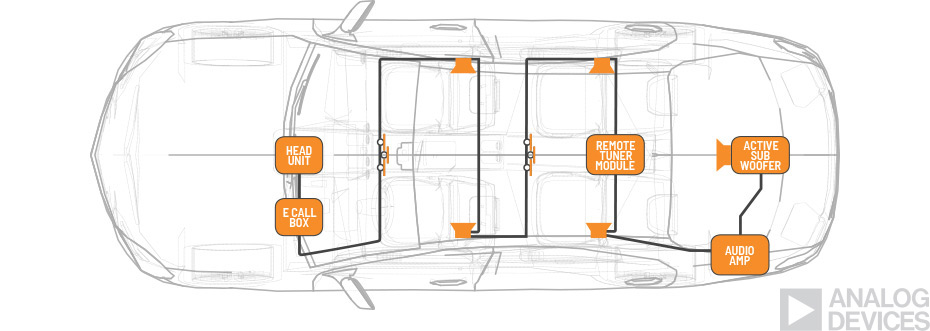
THE FUTURE CAR: CONNECTING YOUR WORLD
Ultimately, uninterrupted and high speed network connectivity are critical to enable high degree digitization of the car of tomorrow. ADI’s latest offering, Ethernet-to-the-Edge Bus (E2B), uses the new automotive Ethernet 10BASE-T1S technology to enable Ethernet-to-edge connectivity for sensors and actuators. This eases the transition to zonal-based architectures, bringing considerable cable savings, significantly reducing the number of ECU’s, and supporting over-the-air updates rolling out new and enhanced features.
Development work continues at a fast rate to help car manufacturers realize a new vision for the automotive, in-cabin experience—one that owes much to the cell phone, but which respects the safety and reliability priorities of the automotive industry.
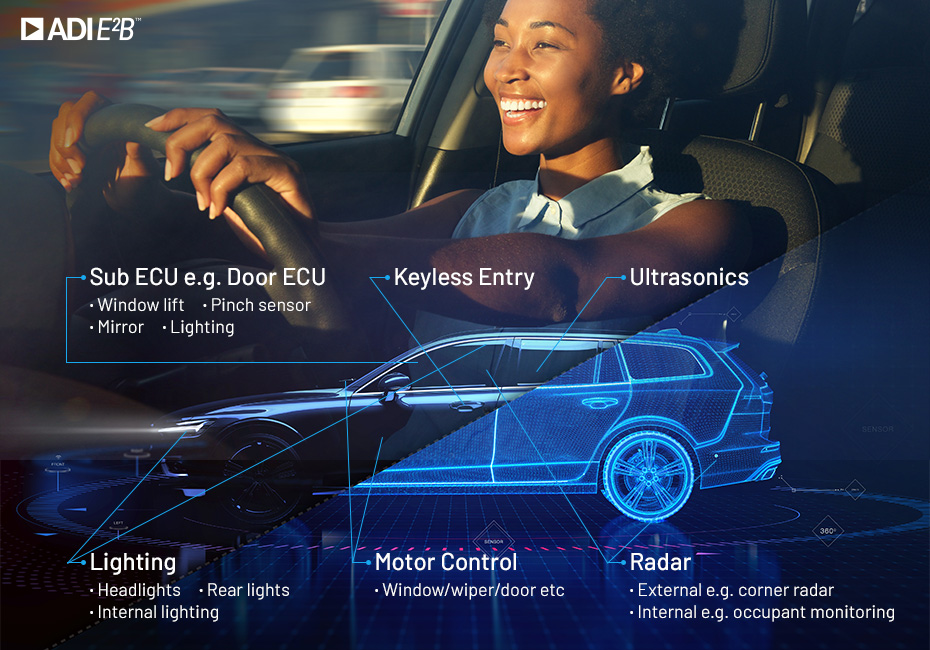
1 In-Cabin Automotive AI Market - A Global and Regional Analysis: Focus on Product Types, Applications, and Country Assessment - Analysis and Forecast, 2020-2026 (researchandmarkets.com)
2 How do we get consumers to love connected cars? | IoT Now News & Reports (iot-now.com)

